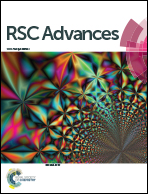Carbon dots based turn-on fluorescent probes for the sensitive determination of glyphosate in environmental water samples†
Abstract
Fluorescent CDs were prepared by using thiourea as the carbon source and diethylene glycol as the reaction medium. The CDs were obtained only within three minutes under microwave irradiation and their particle size was mainly distributed in the range of 1.5–3.5 nm. The average particle size was 2.3 nm with a standard deviation of 0.5 nm. The fluorescence of the CDs could be quenched by Cu2+ through the static quenching mechanism. On this basis, the CDs can be used as a fluorescence probe for detection of Cu2+ in a linear range of 0.2–25 μmol L−1, and the limit of detection was 0.05 μmol L−1. The quenched fluorescence of the CDs could be recovered with the addition of glyphosate based on a competitive affinity for Cu2+ between glyphosate and the functional groups on the surface of CDs, which provides a turn-on sensing strategy for determination of glyphosate. Under the optimal conditions, the linear range of the method was 0.03–10 μg mL−1 with a detection limit of 16 ng mL−1. Finally, this fluorescence probe was successfully applied to the direct determination of glyphosate in environmental water samples and satisfactory results were obtained.


 Please wait while we load your content...
Please wait while we load your content...